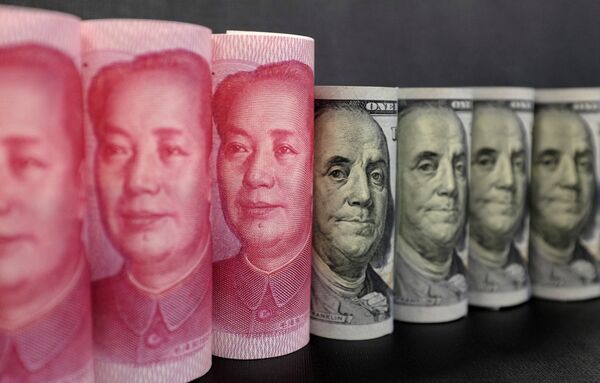The digital yuan, formally known as the Digital Currency Electronic Payment (DCEP), is no threat to the US dollar or any other globally accepted fiat currency, according to former People’s Bank of China (PBoC) Governor Zhou Xiaochuan, who discussed the cyber cash at the Shanghai Financial Forum earlier this month.
"If you are willing to use it, the yuan can be used for trade and investment", he said, as quoted by the South China Morning Post. "We don’t have an ambition to replace existing currencies".
According to Zhou, if the digital yuan goes into circulation, it will facilitate the process of international settlements and make it possible to instantly convert currencies while shopping. This is the first time that the ex-PBoC governor has spoken publicly about China's state digital currency project.
China's New Digital Cash is Gaining Steam
"At the current stage, one can say that the digital yuan, being a replacement for M0 [i.e. central bank notes and coins], will mainly serve as a means of payment and cash in circulation", explains Dr Chen Fengying, economist and senior fellow at the China Institute of Contemporary International Relations. "For ordinary people, it will be a more reliable means of payment, will be much more secure than the existing payment systems Alipay and WeChatPay".
Furthermore, the digital yuan can be used even without an Internet connection, he stresses, explaining that this is a huge advantage given that the existing mobile payment systems require an Internet connection to complete a transaction.
Mobile payments have proven to be especially effective during the COVID-19 pandemic, when economic activity went online due to nationwide lockdowns, according to the academic. At the same time, Chinese elderly persons who do not have smartphones connected to the Internet have found it difficult to get the full range of financial services they need. The digital yuan could solve this problem: the system will work both through an Internet connection and Radio Frequency IDentification (RFID) technology.
The new digital currency is being tested in several Chinese cities, including Shenzhen, Suzhou, Chengdu, and Xiongan, a satellite city of Beijing. Shenzhen took the lead in October 2020 issuing 10 million yuan worth of digital currency to 50,000 random residents who applied for the experiment. JD.COM, one of the largest e-commerce services, has also jumped on the project's bandwagon, showing that the digital yuan can also be spent for online purchases.
The tests are aimed at considering all possible scenarios for using the digital currency and the risks associated with the financial operations. The trials taking place in China's cities are meant to use DCEP as a replacement for cash. However, the real potential of the digital yuan can be revealed through cross-border use, Chen underscores.
Digital Yuan Can Come in Handy in Cross-Border Trade
The digital yuan may prove especially convenient as a tool of international payments, he insists. Chen notes that right now it is nothing more than an M0 unit, but DCEP has the potential of becoming M2, i.e. a measure of the money supply that includes cash, checking deposits, and convertible "near money".
"If DCEP becomes M2 and is used for cross-border payments, it will significantly reduce transaction costs and make payments more convenient", he says. "Of course, the key point is security, namely, the reduction of currency risks. Due to fluctuations in exchange rates, trading and investment activities are severely limited. If you use digital currency in trading, you can avoid the impact of exchange rate volatility. In general, I believe that monetary pluralism is a global development trend, and this is a problem that cannot be solved by one country".
During his December speech in Shanghai, Zhou Xiaochuan explained that cross-border payments are carried out using either credit cards or mobile payment systems. However, both currency conversion and money transactions do not always go through smoothly, because the process is quite complicated, according to Zhou. If the digital yuan allows these procedures to be carried out simultaneously and instantly, this will be a significant improvement in the international settlement system.
Chen believes that various international organisations will step forward to coordinate relations between countries in order to create a diversified world where different currencies would not compete with each other. "I think this is the future we want", he opines.

DCEP Has a Long Way to Go Before Going Global
China kicked off the digital currency project in 2014, when Zhou Xiaochuan was still the head of the People's Bank of China. The PRC authorities kept silent about the DCEP project until 2019. Shortly before the digital yuan was ready for pilot tests, the Central Bank of China revealed some of its technical details. It was reported, in particular, that the digital yuan would replace cash in circulation, while screenshots of DCEP digital wallets leaked online suggested that their user interfaces would closely resemble such Chinese mobile payment systems as Alipay and WeChatPay. However, unlike Alipay and WeChatPay, DCEP is a complete analogue of fiat currency, which has all the functions of cash and the same sovereignty.
"DCEP is a 'two-tier' research and development and pilot project plan of the People's Bank of China", reads Zhou Xiaochuan's op-ed published in China Daily on 21 December 2020. "In the two-tier system of DCEP, the PBOC is on the first tier. Commercial banks, telecom operators and internet payment platforms are on the second tier".
Following the trials in Shenzhen, Suzhou, Chengdu, and Xiongan, the digital yuan may be tested more widely during the Beijing Winter Olympics in 2022. If international traders consider the digital yuan attractive, they will be allowed to use it too. However, there is still a long way to go before DCEP becomes an international means of payment: according to the most optimistic forecasts, the digital yuan won't get into free circulation within the country until 2023.





